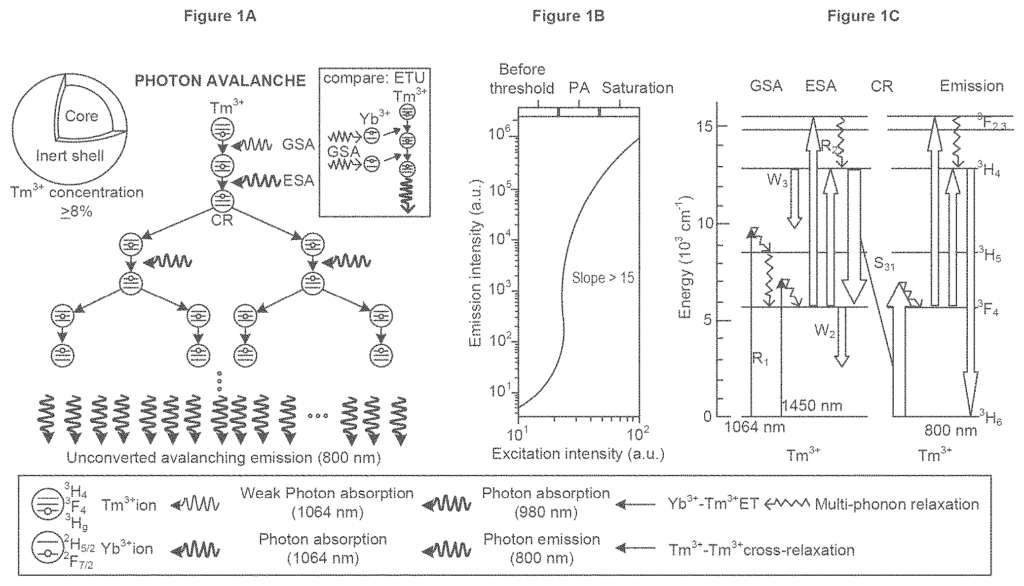Unlocking Enhanced Optical Performance with Photon Avalanching Nanoparticles
Introduction
Nonlinear optics has long been a critical field in advancing technologies such as telecommunications, high-resolution imaging, and quantum computing. However, generating strong nonlinear optical responses typically requires intense light fields or sophisticated setups that are not always practical for widespread commercial applications. Our patented system introduces a groundbreaking approach using photon avalanching nanoparticles to create giant nonlinear optical responses, offering enhanced optical performance across a wide range of industries, from telecommunications to medical imaging.
The Need for More Efficient Nonlinear Optical Systems
Traditional methods of achieving nonlinear optical responses often rely on high-intensity laser beams or complex arrangements of materials. This poses significant limitations, including the need for expensive equipment and inefficient energy use. For industries like optoelectronics and telecommunications, where speed, efficiency, and precision are paramount, finding ways to improve nonlinear optical interactions while minimizing complexity is critical.
In biomedical imaging, the need for high-resolution techniques capable of penetrating deeper into tissues has also grown, and nonlinear optics provides a promising solution. Yet, the challenge remains in scaling these systems for broader applications that can be both cost-effective and highly efficient.
Photon Avalanching Nanoparticles: A Game-Changing Approach
Our patented system leverages photon avalanching nanoparticles to generate giant nonlinear optical responses. These nanoparticles amplify the optical signal by a cascading process that creates an avalanche effect, delivering significantly stronger responses from lower light intensities. This approach drastically improves the efficiency of nonlinear optical systems while reducing the complexity and cost traditionally associated with such technologies.
The enhanced optical responses made possible by this system open up numerous applications, including telecommunications systems that require fast, accurate data transmission and optoelectronic devices that rely on precise light manipulation. Moreover, this technology is particularly well-suited for the healthcare sector, where nonlinear optical effects can be used to develop next-generation imaging systems with greater resolution and depth. In quantum computing, the use of photon avalanching nanoparticles can lead to more efficient optical systems, enhancing computational power and stability.
Key Benefits
- Enhanced Optical Responses: The system’s ability to generate strong nonlinear responses from lower-intensity light leads to more efficient optical systems across multiple industries.
- Reduced Complexity: By using photon avalanching nanoparticles, the need for high-intensity lasers and complex setups is minimized, making the technology more accessible.
- Versatile Applications: From telecommunications to healthcare imaging and quantum research, this system has wide-ranging potential for improving performance and precision.
- Cost-Effective Solution: The reduced need for high-power sources and intricate designs translates to lower costs and greater scalability for commercial use.
A New Standard in Nonlinear Optics
Licensing this system for facilitating giant nonlinear optical responses with photon avalanching nanoparticles offers an opportunity to bring cutting-edge technology to industries seeking more efficient, precise, and scalable optical solutions. Whether applied in telecommunications, optoelectronics, or advanced imaging, this innovation represents the future of high-performance optical systems.

- Abstract
- Claims
What is claimed is:
1. A nanoparticle for inducing photon avalanching, comprising:
9. A nanoparticle for inducing photon avalanching, comprising:
14. A method for inducing photon avalanching, comprising:
Share
Title
System and method for providing and/or facilitating giant nonlinear optical responses from photon avalanching nanoparticles
Inventor(s)
P. James Schuck, Changwan Lee, Emma Xu, Kaiyuan Yao, Emory Chan, Bruce Cohen, Ayelet Teitelboim, Yawei Liu, Yung Doug Suh, Sang Hwan Nam
Assignee(s)
Columbia University in the City of New York
Patent #
20220163384
Patent Date
May 26, 2022
